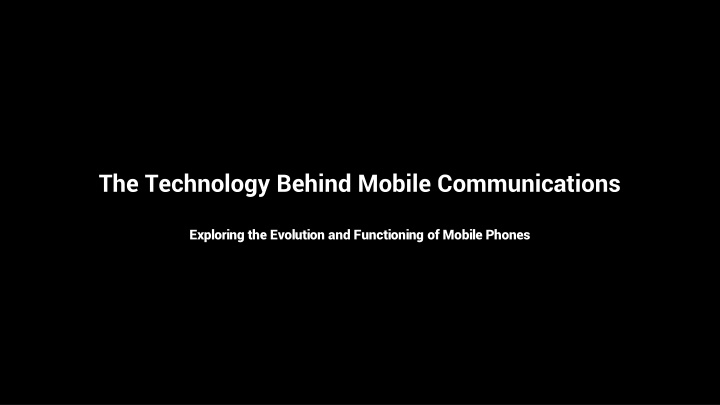
Exploring Mobile Communications Technology Evolution
Discover the fascinating evolution and workings of mobile phones, from voice to digital signal conversion to the limitations of electromagnetic waves and the concept of cellular technology. Explore how mobile switching centers and frequency spectrum management play vital roles in mobile phone communications. Learn about the evolution of mobile phone technologies from 1G analog to 2G digital advancements like SMS and internet browsing.
Download Presentation

Please find below an Image/Link to download the presentation.
The content on the website is provided AS IS for your information and personal use only. It may not be sold, licensed, or shared on other websites without obtaining consent from the author. If you encounter any issues during the download, it is possible that the publisher has removed the file from their server.
You are allowed to download the files provided on this website for personal or commercial use, subject to the condition that they are used lawfully. All files are the property of their respective owners.
The content on the website is provided AS IS for your information and personal use only. It may not be sold, licensed, or shared on other websites without obtaining consent from the author.
E N D
Presentation Transcript
The Technology Behind Mobile Communications Exploring the Evolution and Functioning of Mobile Phones
Introduction Mobile phones are an integral part of our lives Curiosity about mobile communications technology Understanding how phones make calls and different generations Exploring the technology behind mobile communications Photo by Pexels Photo by Pexels
Voice to Digital Signal Voice picked up by phone's microphone Microphone converts voice to digital signal Digital signal represented as zeros and ones Antenna transmits zeros and ones as electromagnetic waves Photo by Pexels Photo by Pexels
Limitations of Electromagnetic Waves Electromagnetic waves lose strength over long long distances Obstacles and environmental factors reduce wave reduce wave strength Cell towers introduced to overcome these issues Concept of cellular technology and division into hexagonal cells Photo by Pexels Photo by Pexels
Mobile Switching Center Mobile switching center helps locate cell tower area Subscriber's location updated periodically Location updated when crossing predefined number of towers Location updated when phone is turned on Photo by Pexels Photo by Pexels
Frequency Spectrum and Mobile Phone Communications Limited frequency spectrum for cellular communications Frequency slot distribution among cell towers Multiple access technique for efficient distribution among active users Photo by Pexels Photo by Pexels
Evolution of Mobile Phone Technologies 1G - First wireless phones with analog transmission 1G limitations: poor voice quality and security 2G - Introduction of digital multiple access technologies 2G advancements: SMS and internet browsing Photo by Pexels Photo by Pexels
3G and 4G 3G - Focus on higher data transfer speed 3G advancements: WCD multiple access technique and increased bandwidth 4G - Higher speeds suitable for high-resolution content 4G advancements: OFD multiple access and MIMO technology Photo by Pexels Photo by Pexels
The Future of Mobile Communications - 5G 5G to support seamless connectivity for the internet of things Enhanced MIMO technology and millimeter waves Suitable for driverless cars and smart homes Photo by Pexels Photo by Pexels
Conclusion Mobile communications are a combination of wireless and wired technology Understanding the underlying technology enhances our appreciation for mobile phones Mobile communications continue to evolve to meet new demands Photo by Pexels Photo by Pexels
